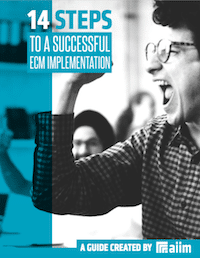The AIIM Blog
Keep your finger on the pulse of Intelligent Information Management with industry news, trends, and best practices.
At a recent holiday gathering (of triple-vaxxed friends/family), I was reminded of advice from my very elegant and wise grandmother: “Always leave a party when you’re having fun.” Since I’m still having a blast at the AIIM party, now is the ideal time for me to make my way to the exit, passing the presidential baton enroute. That’s right. I promised myself that I would serve only two, 3-year terms in the CEO role, yet here I am, happily beginning the third. I believe in executive term limits, so I had best be honoring my own vow.
Share
If you’ve been paying attention to the research we conduct and the educational information we share, you know that AIIM describes Intelligent Information Management (IIM) as all the things you want to do with, or get from, your organization’s information. We break these up into five key categories of actions or aspirations: Creating and Capturing Information Extracting Intelligence from Information Digitalizing Core Business Processes Automating Governance and Compliance Implementing an Information Management Solution
Share

Making an ECM implementation successful requires planning and attention to detail. The best way to create the right solution is to identify organizational goals and priorities. Learn how to manage a successful implementation in our free guide.
In last week's article, we talked about the changing role of M365 within organizations, how it is governed, and how it connects with other content management solutions. Given its rapid evolution and adoption – particularly with the maturation of Office 365 and Cloud versions of SharePoint, we probably should have made a few points about brand terminology. With similar names, "Microsoft 365" and "Office 365" are sometimes used synonymously by users. They are actually different. What's the difference? Let's take a look: The confusion may have started in 2017 with Microsoft's release of Microsoft 365. This new offering bundled a group of their existing products under one license. One of the products included in the bundle is Office 365...you can see where terminology confusion set in. Let's clear things up with the infographic below:
Share
As late as 2010, many end-users and solution providers viewed SharePoint as useful for project groups and document sharing – but more of an interesting tangent to the world of content management than “real” ECM. However, standalone ECM solutions at that time came at a very high cost. Many of these ECM solutions were built for high-volume scanning/capture applications and priced accordingly. So what about those who couldn't afford that investment? What about the middle market masses?
Share
As the AIIM team and I put the finishing touches on AIIM21: a galactic digital experience, our attention is laser-focused on the educational content we bring to this year's participants. We take our upskilling and uplifting responsibilities pretty seriously around here, believing that we have an outsized obligation to move the industry and the community up the business value chain. We know that Information Management leaders of the future rely on AIIM for knowledge and insight. In guiding and prepping the event partners and educators, I revisited an article that AIIM21 keynote speaker, Tom Koulopoulos wrote six years ago. Tom is no stranger to AIIM, having presented at our 2015 conference in San Diego. Here's a picture of him from that event: In the article, Tom offers five predictions for business and technology in the twenty years hence. As we welcome him back to the conference keynote stage, let's take a quick trip back in time to revisit Tom's original forecast from 2015.
Share
Technology and apps that are helping to prevent illness, accidents, and crime also happen to collect a vast amount of personal data. Similarly, some of the video conferencing and collaboration platforms that we knowledge workers are all too familiar with are now using artificial intelligence to recognize participants and their behaviors. Are these new features a boost to efficiency and convenience or simply the latest attempt by providers to push the boundaries between convenience and intrusion?
Share